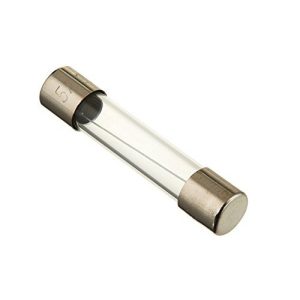 A fuse is a simple and highly effective way to protect a device from dangerous levels of current:
A fuse is a simple and highly effective way to protect a device from dangerous levels of current:
1. Current flowing through a conductor’s nonzero resistance leads to power dissipation.
2. Power is dissipated in the form of heat.
3. Heat raises the temperature of the conductor.
4. If the combination of current amplitude and duration is sufficient to raise the temperature above the fuse’s melting point, the fuse becomes an open circuit and current flow ceases.
Though the fundamental operation of a fuse is not complicated, there are subtle points to keep in mind. The rest of this article will help you to understand some important details related to the behavior and use of fuses.
How a Fuse Is Tripped: Heat, Not Current
A fuse is not tripped directly by current; rather, the current creates heat, and heat trips the fuse. This is actually a rather important distinction because it means that fuse operation is influenced by ambient temperature and by the temporal characteristics of the current. The specified current rating of a fuse is relevant only to a specific ambient temperature (usually, or maybe always, 25°C), and consequently, you need to adjust your fuse selection if you’re designing a device that will operate outdoors in, say, Antarctica or Death Valley.
Connect Fuses In Series!
I’m not going to dwell on this point because it’s so straightforward, but it’s worth mentioning just in case you’re up late designing a schematic and in your exhausted state you don’t notice that you placed the fuse in such a way that it is, for example, in series with only one of two voltage regulators. A fuse cannot protect anything that is connected in parallel with it.
Fuse Design Best Practices: Rated Current vs. Operating Current
It would be perfectly reasonable to assume that a fuse rated for 6 amps could be used in a circuit that might need 5 amps of steady-state current. It turns out, though, that this is not good design practice. The current rating of a fuse is not a high-precision specification, and furthermore (as discussed above) the actual tripping current is influenced by ambient temperature. Consequently, to avoid “nuisance tripping,” you should have a fairly generous gap between your expected steady-state current and your fuse’s rated current.
Why Do Fuses Have a Voltage Rating?
Fuses are designed to have very low resistance so that they don’t unduly interfere with the circuits that they are protecting. This low resistance means that the voltage drop across the fuse will be very small. Why, then, do fuses have a voltage rating? It’s true that fuses see small voltage during normal operation, but the voltage rating is not relevant to normal operation. Rather, the voltage rating tells you what the fuse can endure after it has tripped. A blown fuse is an open circuit, and if the voltage across this open circuit is enough to cause arcing, the fuse can’t be relied upon. It’s a good idea to keep an eye on voltage ratings if you’re using tiny surface-mount fuses, such as the one shown below (note how thin the actual fusing element is). The rating for an 0603 fuse, for example, could be 32 V or even 24 V.
We’ve covered some interesting details about how fuses work and how to effectively incorporate them into our designs, however, meddling around with these devices can’t be everyone’s forte. If you need help, don’t hesitate to contact Nu-Tech. We’ll get you sorted out in no time.


